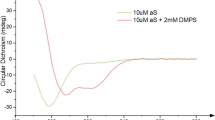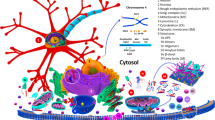Abstract.
α-Synuclein belongs to a small group of natively unfolded proteins that can transiently bind to lipid membranes and acquire a partial α-helical conformation. Under certain pathogenic conditions, α-synuclein aggregates to form oligomers and insoluble fibrils with increased ß-sheet configuration. Although genetic mutations and multiplications of the gene have been found in familial cases, the mechanism by which this protein aggregates in sporadic cases of Parkinson’s disease, dementia with Lewy bodies and multisystem atrophy is not fully understood. Here we review the function of α-synuclein and recent insight into the mechanisms by which it aggregates.
Similar content being viewed by others
Author information
Authors and Affiliations
Corresponding author
Rights and permissions
About this article
Cite this article
Tofaris, G.K., Spillantini, M.G. Physiological and pathological properties of α-synuclein. Cell. Mol. Life Sci. 64, 2194–2201 (2007). https://doi.org/10.1007/s00018-007-7217-5
Published:
Issue Date:
DOI: https://doi.org/10.1007/s00018-007-7217-5




